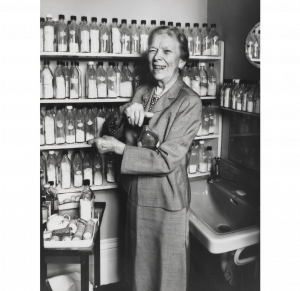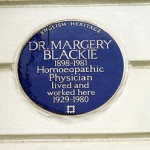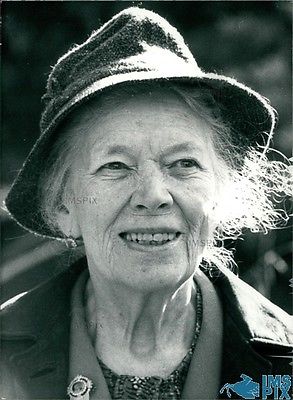 Margery Grace Blackie CVO, MD, FFHom (4 February 1898 – 24 August 1981)was an orthodox doctor who converted to homeopathy. In 1969 she became the homeopathic physician of Queen Elizabeth II, the first woman ever to be appointed as physician to the Crown.
Margery Grace Blackie CVO, MD, FFHom (4 February 1898 – 24 August 1981)was an orthodox doctor who converted to homeopathy. In 1969 she became the homeopathic physician of Queen Elizabeth II, the first woman ever to be appointed as physician to the Crown.
For more than four decades Blackie was affiliated with the Royal London Homeopathic Hospital (RLHH), as physician (1937-57) and senior consultant physician (1957-66). Towards the end of her RLHH career she was assisted by, and later the patient of, Charles Kennedy Elliott who, in 1980, succeeded her as royal physician to Queen Elizabeth II.
Blackie was also a colleague of such notable RLHH physicians as Sir John Weir, Charles Edwin Wheeler, Queenie Muriel Francis Adams, Alva Benjamin, Philip Norman Cutner, Ronald William Davey, Anita Davies, Donald MacDonald Foubister, John Stephen Hughes Games, Thomas Maughan, Kathleen Priestman, William Eldon Tucker, Llewelyn Ralph Twentyman, Frank Parker Wood, and many others. Blackie’s friend and assistant, Sergei William Kadleigh, was among the victims of the 1972 Staines Air Disaster; Blackie provided Kadleigh’s obituary in the October 1972 issue of the British Journal of Homeopathy.
On Tuesday, 31 December 1968, the front page of the the The London Gazette carried a notice in its “State Intelligence” section issued by the Lord Chamberlain’s Office announcing that:
“Sir John Weir, G.C.V.O., M.B., Ch.B., F.F.Hom., retires from his appointment as Physician to The QUEEN. The QUEEN has been graciously pleased to appoint Margery Grace Blackie, M.D., M.B., B.S., M.R.C.S., L.R.C.P., F.F.Hom., to be a Physician to Her Majesty.”
Weir’s successor as royal physician, Margery Grace Blackie, was born on 4 February, 1898, in the village of Redbourn, Hertfordshire to a Scottish father, Robert, and Welsh Mother, Lizzie. She spent her formative years in and around the southern counties of England and in 1911 the family moved to West London, where she became a day girl at the Haberdashers’ Aske’s School in Acton.
Blackie’s family also had connections with Liverpool, a city with a longstanding homeopathic presence, and it was there in 1874 that her uncle by marriage, Dr. James Compton Burnett, had established a highly successful homeopathic practice. Blackie’s father, Robert, had become a believer in homeopathy around this time, and in 1875 he married Elizabeth (“Lizzie”) Rees, the sister of Compton Burnett’s wife Katherine, and of the architect and civil engineer Rowland Rees.
Intent on an orthodox medical career, in 1917 Blackie entered the London (Royal Free Hospital) School of Medicine for Women, one of the University of London medical schools, and the only one at that time accepting women medical students.
While still a student, in 1924 Blackie joined the staff as a resident at the RLHH. There she practiced under the tutelage of some of the leading figures in British homeopathy, including the venerable John Henry Clarke, Charles Edwin Wheeler, Douglas Borland, and her lifelong friend Frank Bodman.

Margery Grace Blackie in her London flat by Mayotte Magnus, bromide print, July 1977
The following year in 1929 Blackie set up in private practice with her homeopathic colleague, Dr. Helena Banks, at 18 Alfred Place ( later number 18 Thurloe Street), Kensington. This was to remain her London residence and private practice for the rest of her life.
18 Thurloe Street, London, SW7 was ideally suited to Blackie and served as her home as well as her consulting room. It had a homely atmosphere, and there was always an open fire in the consulting room to welcome patients, students and homeopaths, who would travel from all over the world to sit in during her surgeries.
Here, she developed sound consulting-room methods and encouraged patients to tell their story in their own way, while also making a clinical diagnosis of her patients, using conventional methods such as x-rays and pathological tests. Her aim was simple – to understand her patients as deeply as possible.
During the 1930’s, Blackie continued to work at the London Homoeopathic Hospital, but spent most of her time developing her own practice. Her flair for diagnosis had become legendary. Patients included a number of public figures such as Dame Myra Hess and Lady Namier. In 1949, Blackie was elected President of the revitalised Faculty of Homoeopathy.
In 1929, Blackie became clinical assistant in the children’s department at the Royal London Homeopathic Hospital under the supervision of highly regarded homeopath Douglas Morris Borland, himself a former student of pioneering American homeopathic physician, James Tyler Kent.
Blackie combined her work in private practice with her duties at the RLHH, including teaching students at the RLHH-affiliated London Missionary School of Medicine.
Eight years later, in 1937, Blackie was appointed physician (1937-57) at the hospital, and in 1957 senior consultant physician (1957-66). Throughout her career she was an active member of the homeopathic research community, contributing journal papers and presenting conference talks, including delivering the 1959 Richard Hughes Memorial Lecture at the RLHH. Even after her retirement in 1966, aged 69, Blackie continued in private practice, where she was joined by her protégé, Anita Davies, and continued to serve as honorary consultant to the RLHH.
By 1964, Blackie was one of the best known and well respected physicians in the British homeopathic profession. That year she was elected Dean of the Faculty of Homeopathy with responsibility for all teaching. It was from this position that Blackie influenced a whole new generation of homeopathic doctors, serving in this role until obliged to resign in 1979 due to her own failing health.
By the mid-1970’s, Blackie’s own health was in decline, but she continued to see patients at 18 Thurloe Street, London, SW7 until 1980, when she left London to retire to Hedingham Castle in Essex. It was there that she died on 24 August 1981.
She was admired by her patients for her concerned approach, kindness, and skill.
It is as a brilliant teacher, whose vivid descriptions of various constitutional types of patients became engraved in the minds of her listeners, that her undergraduate and postgraduate students remember her. It was this deep understanding of the characteristics of the individual remedy that formed the basis of her international reputation.
Margery Blackie was the most outstanding homeopathic doctor of her generation; admired by homeopathic and conventional physicians alike. Her sound medical practice and enthusiasm for homeopathy led to its increased acceptance by the wider medical world.
In 1971, Blackie established the Blackie Foundation Trust to help support homeopathic research and teaching. As part
 of the Trust the Margery Blackie Memorial Lecture is held annually at the Royal London Homeopathic Hospital.
of the Trust the Margery Blackie Memorial Lecture is held annually at the Royal London Homeopathic Hospital.
In 1979, Blackie was made a Commander of the Royal Victorian Order for her distinguished service to the Crown.
Note: On 12 October 2004 Blackie was commemorated at her old address with an English Heritage Blue Plaque. The plaque was unveiled by Blackie Trust patron HRH Princess Alexandra.
Select Publications:
- The Patient, Not the Cure: The Challenge of Homoeopathy (London: Macdonald and Jane’s, 1975)
- Classical Homeopathy (Beaconsfield: Beaconsfield Publishers, 1986)
The official biographer of Margery Grace Blackie was Constance Babington Smith. She gave the second Blackie Memorial Lecture, entitled Margery Blackie – The Woman at the Blackie Foundation, on 23 April 1985.
The following year, 1986, Babington-Smith published her biography of Blackie, Champion of Homeopathy: The Life of Margery Blackie.



I would like to know more about this amazing woman ………if you were a friend …a teacher or a student . My grandmother was one of her closest friends and ran a care home for the ailing and elderly at hedingham castle in my younger years . I remember the time she passed as i was in the next room . I now work in a natural herb shop in australia !!!! please contact me …kim
If possible I would like to contact Kim Westmorland regarding Castle Hedingham.
Thanks
I was lucky enough to meet Miss Majendie, Dr Blackie and Mrs Westmoreland when I had a weekend and college job at the castle for two years. (1977 – 1979)
I had a great experience working there and the ladies and gentlemen who lived there were always pleasent.
But I remember Mrs Westmoreland fondly as she always used to walk down the drive to the hut at the gates to the castle when I worked on the gate when the castle was open with tea and cakes for me.
Some wonderfull memories from a long time ago
Marjorie Blackie used to commute into London on the train with other hom doctors. They used to play a game of spotting the constitutional types as the train slowed into the station.
When John Ainsworth was kicked out of Nelsons and started his own homoeopathic pharmacy, Marjorie supported him by bringing prescriptions for her patients. When these included those for HM The Queen and HM The Queen Mother, Nelsons bosses got irate and insisted she bring to them instead as they had the Royal Warrants of appointment to their majesties. A red rag to a bull, Blackie said we’ll see about this and had the warrants transferred to Ainsworths in 1980 and 1981 respectively. Usually one had to trade with the royal household for a minimum of three years before the application of a warrant to a past, future or present monarch was possible, but Blackie as a member of the Royal Household arranged this in just two years. Unprecedented!
Thank you very much for this illuminating anecdote, Tony.
Tony…Thank YOU for your comment here. A real bit of history!
What a wonderful anecdote, Tony. Thank you for sharing! Margery was an amazing individual who made such strides for homeopathy and for women in medicine.